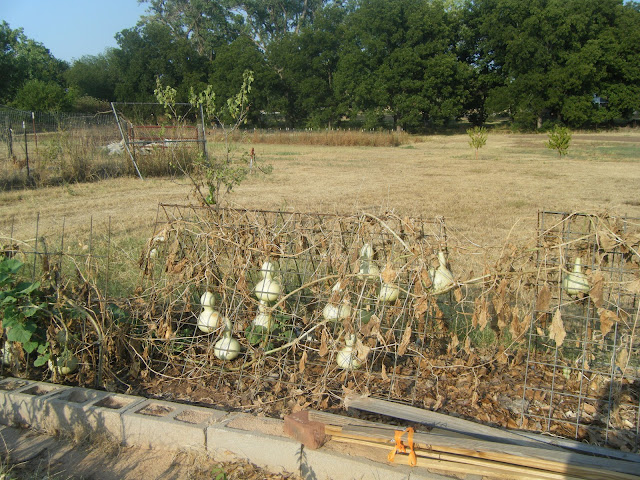I have tried not to whine about the weather this summer like I did last summer. But, it has been another terrible hot, dry summer. In fact, it seems the drought is wider spread this year and includes all the mid-west. This is supposed to be the worst drought since the 1930s. At that time, it was termed the "dust bowl" here in Oklahoma. There have been news reports that the water in the Mississippi river has dropped so low that barges are having trouble getting through certain spots in the river.
Last summer I wrote a blog entry concerning my thoughts on the drought:
I've been anxiously watching the level of water in the pond pictured there. So far the sewer pipe is still submerged, but I'm afraid it is going to begin to show above the water any day now. In short, we need rain badly.
Ah, but that is not what I started out to write about. So, I'd better get back on topic! Due to the drought and hot weather, our poor tomato plants have shriveled up and died. We just were not able to water them enough. However, before they bit the dust, Tom picked all the fruit that was left on the vines. He was able to salvage quite a few Roma tomatoes. And, I had to decide how best to preserve them. I really did not want to heat up the kitchen in order to can them and I already had quite a few in my freezer. So, I decided to dry them.
I had not used my food dehydrator in a couple of years, so I dug it out and dusted it off. Here is a picture of it.
I like this kind because it brings air in from the back and blows it across the racks that are inside which exposes the food inside to air more uniformly than some other dehydrators.
It also has controls on top where you set the appropriate time and temperature for different foods.
First step was to wash, core and slice the tomatoes. I sliced them about a quarter of an inch thick.
Next step - place them on the dehydrator racks.
This dehydrator has 5 racks and can dry a lot of produce. Here it is fully loaded.
I set the temperature for 135 degrees, the setting recommended for fruit. I then set the timer for about 14 hours. After about 8 hours, I began checking them for dryness periodically. Here is what they looked like after they were dry. It took some of them longer than others. So, I removed some earlier than others and consolidated those that remained onto the other racks until they were all dry.
Isn't is amazing how much they shrunk during the drying process!
Finally, the dried tomatoes should be stored in an air tight container. Normally, I would have used zip-top plastic bags. But, I had this empty plastic jar that has an air tight lid. Can you believe that I got all the tomatoes that were on those 5 trays in this one little jar!
Now, I just have to figure out how to use dried tomatoes. Any ideas or recipes would be appreciated!






























